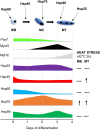Expression and localization of heat-shock proteins during skeletal muscle cell proliferation and differentiation and the impact of heat stress
- PMID: 31098840
- PMCID: PMC6657410
- DOI: 10.1007/s12192-019-01001-2
Expression and localization of heat-shock proteins during skeletal muscle cell proliferation and differentiation and the impact of heat stress
Abstract
Skeletal myogenesis is a coordinated sequence of events associated with dramatic changes in cell morphology, motility, and metabolism, which causes cellular stress and alters proteostasis. Chaperones, such as heat-shock proteins (HSPs), play important roles in limiting cellular stresses and maintaining proteostasis, but whether HSPs are specifically involved in myogenesis is not well understood. Here, we characterized gene and protein expression and subcellular localization of various HSPs in proliferating C2C12 myoblasts and differentiating myotubes under control conditions and in response to heat stress. Hsp25, Hsp40, and Hsp60 protein expression declined by 48, 35, and 83%, respectively, during differentiation. In contrast, Hsp70 protein levels doubled during early differentiation. Hsp25 was predominantly localized to the cytoplasm of myoblasts and myotubes but formed distinct aggregates in perinuclear spaces of myoblasts after heat-shock. Hsp40 was distributed diffusely throughout the cytoplasm and nucleus and, after heat-shock, translocated to the nucleus of myoblasts but formed aggregates in myotubes. Hsp60 localized to the perinuclear space in myoblasts but was distributed more diffusely across the cytoplasm in myotubes. Hsp70 was expressed diffusely throughout the cytoplasm and nucleus and translocated to the nucleus after heat-shock in myoblasts, but not in myotubes. Hsp90 was expressed diffusely across the cytoplasm in both myoblasts and myotubes under control conditions and did not change in response to heat-shock. These findings reveal distinct and different roles for HSPs in the regulation of myogenic cell proliferation and differentiation.
Keywords: C2C12; Heat-shock proteins; Molecular chaperones; Muscle development; Myogenesis; Skeletal muscle.
Figures






References
-
- Cheng H, Cenciarelli C, Nelkin G, Tsan R, Fan D, Cheng-Mayer C, Fidler IJ. Molecular mechanism of hTid-1, the human homolog of Drosophila tumor suppressor l(2)Tid, in the regulation of NF-kappaB activity and suppression of tumor growth. Mol Cell Biol. 2005;25:44–59. doi: 10.1128/MCB.25.1.44-59.2005. - DOI - PMC - PubMed
Publication types
MeSH terms
Substances
LinkOut - more resources
Full Text Sources
Research Materials
Miscellaneous

